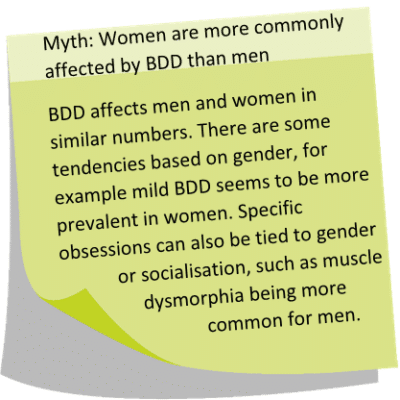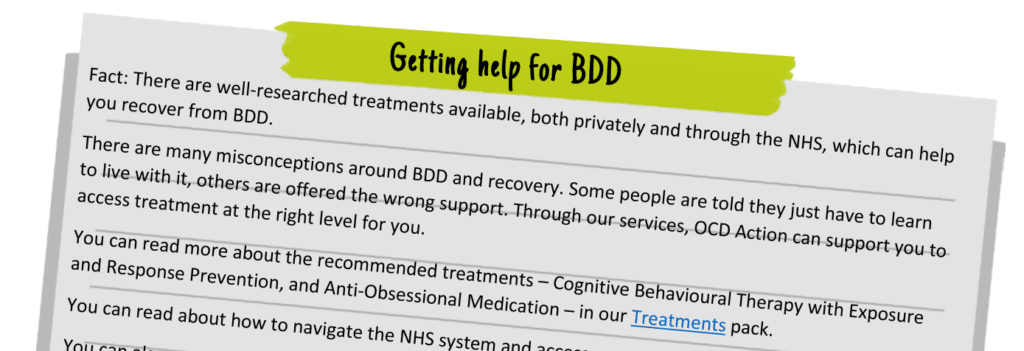.
Body Dysmorphic Disorder (BDD) is the name given to a recognised condition that causes a person to become deeply preoccupied with a perceived fault in their appearance, which pulls them into a cycle of distressing obsessions and compulsions around the way they look.
BDD is a very debilitating and often misunderstood condition, so much so that many hide it for years or decades. Estimates about how many people live with BDD can vary greatly between 0.7% and over 2%, because even those who reach out for help might feel too embarrassed to talk about what they’re experiencing. The good news is that BDD is a treatable condition, with both therapy and medication available that can help with management and recovery.
Obsessions
Obsessions in BDD revolve around one or more perceived problems with the way someone looks. This might be something only noticeable to you, something minor and slightly noticeable, or a normal change in appearance like wrinkles or male pattern baldness. What defines the obsessions is that they are excessive and very distressing, causing someone to associate their perceived ugliness with rejection, worthlessness, and hopelessness. An older term for BDD is ‘imagined ugliness syndrome’, but the term ‘imagined’ misrepresents the condition, which causes the ugliness and distress to be felt in a very real way. The term ‘perceived’, which means felt, is more accurate.
Part of the obsessive cycle of BDD are intrusive thoughts about appearance. Intrusive thoughts are random and automatic worries, images, or sensations that everyone experiences as part of being human. They are the result of the brain constantly scanning for interest or danger, and hold no meaning in themselves. They are hypothetical in nature, so most people describe them with the words “What if…”. To someone without OCD or BDD, most of them go by without notice, while others might catch someone’s attention briefly because of the topic they are about. If you struggle with BDD, intrusive thoughts about looks or ugliness, or how people might respond to you because of this, will particularly ‘loud’, upsetting, and difficult to let go of.
Intrusive experiences in BDD can also include memories of people being critical of your appearance, which will be given centre stage over any memories of compliments. You might also have images flash in your mind of what you worry you look like, in which the perceived faults are more heightened and noticeable, or feel sensations in your body that are caused by and bring more attention to the areas you feel are ugly. Obsessions occur because these intrusive thoughts cause both shame and anxiety, which makes it so difficult to dismiss them or move on. Instead, you are likely to pay them more and more attention with time.
The focus of someone’s obsessions can be any part of their body or appearance. The most common areas someone might obsess over are skin, facial features, hair, symmetry, or muscle size. BDD can also cause someone to focus on the way their clothes look or even the appearance of close others (called ‘BDD by proxy’, which there has not been much research on so far). It is important to remember that the obsessions and concerns are driven by fear of ugliness and catastrophic assumptions about what being ugly would mean, not by vanity. Vanity, which revolves around feeling or wanting to be attractive, is not part of the experience of BDD.
People who struggle with BDD have different levels of awareness about their condition and the nature of their thoughts and worries. Some are aware that they are reacting disproportionately to the ‘fault’, but are still unable to let go of it, because of the overwhelming fear and shame they feel. On the other end, obsessions in BDD can feel so convincing that they take on a ‘delusional quality’, meaning the person is convinced of their ugliness. If you are offered reassurance about what you look like, you might notice yourself dismissing this as just something people say to try to make you feel better.
Compulsions
Compulsions are purposeful actions that a person with BDD uses to get some relief from the anxiety and shame. These can be avoidance behaviours, in order to prevent these feelings being triggered, or checking and camouflaging compulsions. Taking part in compulsions is a reaction to the unbearable feelings brought on by obsessions, but the solutions then become part of the problem, as compulsions bring more attention to the topic of the obsession and the relief they bring reinforces the cycle.
People with BDD often avoid social situations, knowing that they will feel embarrassment and self-consciousness if they go. You might also avoid looking at mirrors, again in an attempt not to start the obsessive cycle. Through avoidance, though, public situations and visibility become more scary, and someone might become practically homebound because of how overwhelming the idea of being seen becomes.
Checking compulsions can include repeatedly and uncontrollably looking in the mirror, touching one’s skin to feel shape and texture, or asking for reassurance from others about how they look. This can give a sense of ‘keeping an eye’ on how you might look to others. Like with all other compulsions, this can become more and more engrained with time, making the checking feel increasingly necessary.
Different methods can also be used to camouflage or alter appearance. Depending on the person’s focus, this might involve using make-up, picking at skin, cutting hair, or wearing clothes with lots of cover. Someone might make repeated visits to professionals such as dermatologists or cosmetic surgeons in an attempt to find a permanent solution to their perceived faults, or even perform cosmetic alterations on themselves. Muscle dysmorphia, in which the person becomes obsessed with muscle size and feels they are too small or ‘puny’, can bring to use of anabolic steroids, strict diets, or excessive exercise.
Finally, rumination, or overthinking, is a common response to fears of ugliness, and can be a particularly ‘sticky’ part of the cycle. You might spend a lot of their time and focus asking yourself abstract questions (‘Why was I born this way?’) or trying to find a hypothetical solution (‘If only this part of me looked a little different’). These are an understandable response to the feelings brought on by BDD, but unfortunately only bring more attention and confirmation to the obsessions.
Causes
There has been limited research into BDD and its causes. Like many mental health conditions, it seems to be a mix of genetic tendency, psychological factors, and experiences. BDD most commonly begins in late adolescence, often with milder symptoms in the years before, but can be experienced at any point in life. Small children as young as 5 have been found to display symptoms of it, but it is rare for a diagnosis to be given before the age of 12.
children as young as 5 have been found to display symptoms of it, but it is rare for a diagnosis to be given before the age of 12.
Genetic – BDD and related symptoms tend to run in families. Family members of people with BDD might have the condition itself, other anxiety-based struggles, or depression
Psychological – Individual tendencies like being vulnerable to stress and shame, perfectionism, or a sense of worth that is strongly affected by others’ opinions could be tied into why a person gets so ‘stuck’ in the BDD cycle
Environmental – The experiences and societal values someone is exposed to in their life can inform assumptions or pressures that become a part of the person’s BDD symptoms. For example, being teased or bullied about appearance can be a pre-curser and these memories or messages can become part of the person’s obsessions, even if their appearance has changed since the teasing happened
A trigger is the event or experience that brings on the symptoms. This can be a single traumatic event or, in most cases, the build-up of life stressors eventually ‘spilling over’.
Some people know at least in part what brought on their symptoms, while for others it was mainly a case of bad luck. The good news is that the treatment for BDD is not based on the cause or trigger, so there’s no need to figure it out. Rather, it looks at getting you ‘unstuck’ from the BDD cycle you are currently in through changing your relationship to the thoughts and practicing new reactions to them.
Severity and impact
BDD is a condition that varies from person to person, not only around themes and compulsions but also in levels of severity, constancy, and awareness.
While the impact of BDD ranges from mild to very severe, each person’s distress is real. Everyone experiences obsessions and compulsions on occasion, but for the experience to be labelled ‘disorder’ (the D in BDD) they have to cause distress and impact noticeably on your quality of life. Many people are concerned with the way they look and might use the same methods to feel better, but to fall under BDD this must take at least an hour per day of someone’s attention and be done in response to a deep distress. It will also only have a limited effect on the person’s ability to engage in day to day life. The ugliness or upset you might feel about the way you look is kept up by fear and shame, so will not go away with the right change in appearance. Rather, specific treatments can help you step back from the cycle at your own pace.
The intensity of the anxiety and shame that are brought on by BDD can be debilitating, exhausting, and often constant. Without treatment, it can feel like there is no way out of feeling the way you do about how you look. You might struggle with low moods or depression because of it. It is very important to remember that there is hope, and BDD is a treatable condition that you can recover and get your life back from.


